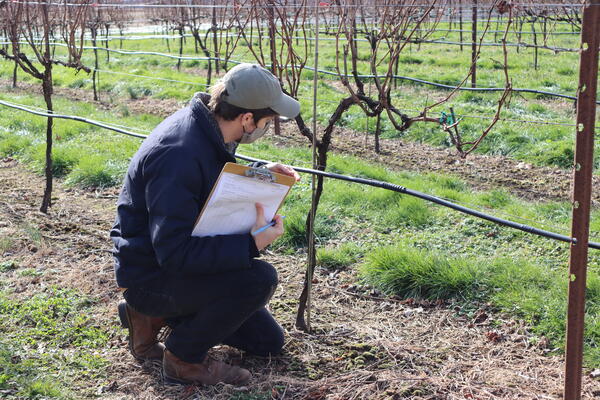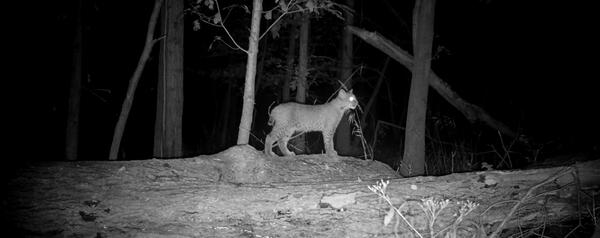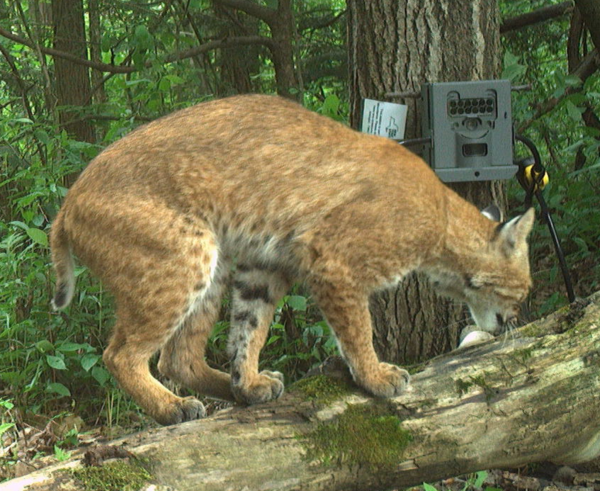USGS researchers at the New York Cooperative Fish and Wildlife Research Unit are using trail cameras to track bobcats, black bears, and coyotes across New York. The researchers created an online database where the public can report wildlife sightings.
Angela Fuller, PhD
Unit Leader - New York Cooperative Fish and Wildlife Research Unit
Research Interests
The single unifying theme of Angela's research program that transcends all projects is that they provide information that contributes to the conservation or management of wildlife species and that has an impact on the way species are managed. The first area of her research is on how spatial variation in the environment influences resource use, movements, and population ecology of mammals. This research is focused primarily on mammalian carnivores, which have many traits that make them especially susceptible to landscape change (e.g., large home ranges, relatively low population densities, and long dispersal distances). She frequently uses non-invasive sampling methods that do not require direct capture of individuals. Using these noninvasively collected samples from carnivores, she employs methods for population estimation that incorporate spatial or landscape processes to help explain the density of species across a landscape. The second major program area of her research is in applying structured decision making (SDM) and adaptive management to guide natural resource management and policy outcomes. SDM is a process for helping to make management or policy decisions in a clear and transparent way, and involves evaluating how well alternative management strategies do at achieving objectives that have been identified by the decision maker and stakeholders. This work integrates quantitative modeling to help predict outcomes of the management strategies that were developed to achieve the stated objectives. Both of her research areas involve the spatial ecology of species, investigating how spatial landscape patterns influence the distribution, density, or dynamics of animal populations.
Teaching Interests
- Decision Making for Natural Resources
- Landscape Ecology
- Habitat Ecology
- Forest Landscape Planning
Professional Experience
Unit Leader, New York Cooperative Fish and Wildlife Research Unit, 2014-
Assistant Unit Leader, New York Cooperative Fish and Wildlife Research Unit, 2009-2014
Education and Certifications
Ph D University of Maine 2006
MS University of Maine 1999
BS University of Maine at Machias 1996
Science and Products
Capture-recapture meets big data: integrating statistical classification with ecological models of species abundance and occurrence
Spatial Capture-Recapture Models to Estimate Abundance and Density of Animal Populations
DeepFaune New England - Data DeepFaune New England - Data
Moose Health and Parasitic Threats in New York Moose Health and Parasitic Threats in New York
Corresponding dataset for effectiveness of canine-assisted surveillance and human searches for early detection of invasive spotted lanternfly Corresponding dataset for effectiveness of canine-assisted surveillance and human searches for early detection of invasive spotted lanternfly
USGS researchers at the New York Cooperative Fish and Wildlife Research Unit are using trail cameras to track bobcats, black bears, and coyotes across New York. The researchers created an online database where the public can report wildlife sightings.
USGS researchers at the New York Cooperative Fish and Wildlife Research Unit are using trail cameras to track bobcats, black bears, and coyotes across New York. The researchers created an online database where the public can report wildlife sightings.
USGS researchers at the New York Cooperative Fish and Wildlife Research Unit are using trail cameras to track bobcats, black bears, and coyotes across New York. The researchers created an online database where the public can report wildlife sightings.

Technician and trained canine detection dog observe the invasive spotted lanternfly at a vineyard
Technician and trained canine detection dog observe the invasive spotted lanternfly at a vineyardUSGS ecologists at the New York Cooperative Fish and Wildlife Research Unit at Cornell University, are using trained canine scent detection dogs to sniff out invasive spotted lanternfly egg masses in Pennsylvania and New Jersey. Vineyards are especially vulnerable, but tree farms, fruit farms, and nurseries are also at risk of damage.
Technician and trained canine detection dog observe the invasive spotted lanternfly at a vineyard
Technician and trained canine detection dog observe the invasive spotted lanternfly at a vineyardUSGS ecologists at the New York Cooperative Fish and Wildlife Research Unit at Cornell University, are using trained canine scent detection dogs to sniff out invasive spotted lanternfly egg masses in Pennsylvania and New Jersey. Vineyards are especially vulnerable, but tree farms, fruit farms, and nurseries are also at risk of damage.

Canine scent detection dog sniffs out invasive spotted lanternfly at a vineyard in New Jersey
Canine scent detection dog sniffs out invasive spotted lanternfly at a vineyard in New JerseyUSGS researchers at the USGS New York Cooperative Fish and Wildlife Research Unit are investigating invasive spotted lanternfly in Pennsylvania, New Jersey, and New York.
Canine scent detection dog sniffs out invasive spotted lanternfly at a vineyard in New Jersey
Canine scent detection dog sniffs out invasive spotted lanternfly at a vineyard in New JerseyUSGS researchers at the USGS New York Cooperative Fish and Wildlife Research Unit are investigating invasive spotted lanternfly in Pennsylvania, New Jersey, and New York.

Eric Clifton of Cornell University collects data on invasive spotted lanternfly at a vineyard
Eric Clifton of Cornell University collects data on invasive spotted lanternfly at a vineyardUSGS researchers at the USGS New York Cooperative Fish and Wildlife Research Unit are investigating invasive spotted lanternfly in Pennsylvania, New Jersey, and New York. Vineyards are especially vulnerable to invasive spotted lanternfly, but tree farms, fruit farms, and nurseries are also at risk of damage.
Eric Clifton of Cornell University collects data on invasive spotted lanternfly at a vineyard
Eric Clifton of Cornell University collects data on invasive spotted lanternfly at a vineyardUSGS researchers at the USGS New York Cooperative Fish and Wildlife Research Unit are investigating invasive spotted lanternfly in Pennsylvania, New Jersey, and New York. Vineyards are especially vulnerable to invasive spotted lanternfly, but tree farms, fruit farms, and nurseries are also at risk of damage.

Spotted lanternfly egg mass on a support pole at a vineyard
Spotted lanternfly egg mass on a support pole at a vineyardUSGS ecologists at the New York Cooperative Fish and Wildlife Research Unit at Cornell University, are using trained canine scent detection dogs to sniff out invasive spotted lanternfly egg masses in Pennsylvania and New Jersey.
Spotted lanternfly egg mass on a support pole at a vineyard
Spotted lanternfly egg mass on a support pole at a vineyardUSGS ecologists at the New York Cooperative Fish and Wildlife Research Unit at Cornell University, are using trained canine scent detection dogs to sniff out invasive spotted lanternfly egg masses in Pennsylvania and New Jersey.
Parasite‐mediated competition limits dominant cervid competitor Parasite‐mediated competition limits dominant cervid competitor
Highly pathogenic avian influenza virus exposure and infection in free-ranging bobcats (Lynx rufus) in New York, USA Highly pathogenic avian influenza virus exposure and infection in free-ranging bobcats (Lynx rufus) in New York, USA
Effectiveness of canine-assisted surveillance and human searches for early detection of invasive spotted lanternfly Effectiveness of canine-assisted surveillance and human searches for early detection of invasive spotted lanternfly
Abundance-mediated species interactions Abundance-mediated species interactions
Intraguild interactions and abiotic conditions mediate occupancy of mammalian carnivores: Co-occurrence of coyotes–fishers–martens Intraguild interactions and abiotic conditions mediate occupancy of mammalian carnivores: Co-occurrence of coyotes–fishers–martens
Integrating presence-only and detection/non-detection data to estimate distributions and expected abundance of difficult-to-monitor species on a landscape-scale Integrating presence-only and detection/non-detection data to estimate distributions and expected abundance of difficult-to-monitor species on a landscape-scale
Using global remote camera data of a solitary species complex to evaluate the drivers of group formation Using global remote camera data of a solitary species complex to evaluate the drivers of group formation
Landscape-scale population trends in the occurrence and abundance of wildlife populations using long term camera-trapping data Landscape-scale population trends in the occurrence and abundance of wildlife populations using long term camera-trapping data
Pardus in the press: Drivers of leopard (Panthera pardus fusca) attack occurrence on humans in Nepal Pardus in the press: Drivers of leopard (Panthera pardus fusca) attack occurrence on humans in Nepal
Landscape-scale drivers of tayra abundance in the Ecuadorian Andes Landscape-scale drivers of tayra abundance in the Ecuadorian Andes
Perception and trust influence acceptance for black bears more than bear density or conflicts Perception and trust influence acceptance for black bears more than bear density or conflicts
Density-habitat relationships of white-tailed deer (Odocoileus virginianus) in Finland Density-habitat relationships of white-tailed deer (Odocoileus virginianus) in Finland
DeepFaune New England DeepFaune New England
Science and Products
Capture-recapture meets big data: integrating statistical classification with ecological models of species abundance and occurrence
Spatial Capture-Recapture Models to Estimate Abundance and Density of Animal Populations
DeepFaune New England - Data DeepFaune New England - Data
Moose Health and Parasitic Threats in New York Moose Health and Parasitic Threats in New York
Corresponding dataset for effectiveness of canine-assisted surveillance and human searches for early detection of invasive spotted lanternfly Corresponding dataset for effectiveness of canine-assisted surveillance and human searches for early detection of invasive spotted lanternfly
USGS researchers at the New York Cooperative Fish and Wildlife Research Unit are using trail cameras to track bobcats, black bears, and coyotes across New York. The researchers created an online database where the public can report wildlife sightings.
USGS researchers at the New York Cooperative Fish and Wildlife Research Unit are using trail cameras to track bobcats, black bears, and coyotes across New York. The researchers created an online database where the public can report wildlife sightings.
USGS researchers at the New York Cooperative Fish and Wildlife Research Unit are using trail cameras to track bobcats, black bears, and coyotes across New York. The researchers created an online database where the public can report wildlife sightings.
USGS researchers at the New York Cooperative Fish and Wildlife Research Unit are using trail cameras to track bobcats, black bears, and coyotes across New York. The researchers created an online database where the public can report wildlife sightings.

Technician and trained canine detection dog observe the invasive spotted lanternfly at a vineyard
Technician and trained canine detection dog observe the invasive spotted lanternfly at a vineyardUSGS ecologists at the New York Cooperative Fish and Wildlife Research Unit at Cornell University, are using trained canine scent detection dogs to sniff out invasive spotted lanternfly egg masses in Pennsylvania and New Jersey. Vineyards are especially vulnerable, but tree farms, fruit farms, and nurseries are also at risk of damage.
Technician and trained canine detection dog observe the invasive spotted lanternfly at a vineyard
Technician and trained canine detection dog observe the invasive spotted lanternfly at a vineyardUSGS ecologists at the New York Cooperative Fish and Wildlife Research Unit at Cornell University, are using trained canine scent detection dogs to sniff out invasive spotted lanternfly egg masses in Pennsylvania and New Jersey. Vineyards are especially vulnerable, but tree farms, fruit farms, and nurseries are also at risk of damage.

Canine scent detection dog sniffs out invasive spotted lanternfly at a vineyard in New Jersey
Canine scent detection dog sniffs out invasive spotted lanternfly at a vineyard in New JerseyUSGS researchers at the USGS New York Cooperative Fish and Wildlife Research Unit are investigating invasive spotted lanternfly in Pennsylvania, New Jersey, and New York.
Canine scent detection dog sniffs out invasive spotted lanternfly at a vineyard in New Jersey
Canine scent detection dog sniffs out invasive spotted lanternfly at a vineyard in New JerseyUSGS researchers at the USGS New York Cooperative Fish and Wildlife Research Unit are investigating invasive spotted lanternfly in Pennsylvania, New Jersey, and New York.

Eric Clifton of Cornell University collects data on invasive spotted lanternfly at a vineyard
Eric Clifton of Cornell University collects data on invasive spotted lanternfly at a vineyardUSGS researchers at the USGS New York Cooperative Fish and Wildlife Research Unit are investigating invasive spotted lanternfly in Pennsylvania, New Jersey, and New York. Vineyards are especially vulnerable to invasive spotted lanternfly, but tree farms, fruit farms, and nurseries are also at risk of damage.
Eric Clifton of Cornell University collects data on invasive spotted lanternfly at a vineyard
Eric Clifton of Cornell University collects data on invasive spotted lanternfly at a vineyardUSGS researchers at the USGS New York Cooperative Fish and Wildlife Research Unit are investigating invasive spotted lanternfly in Pennsylvania, New Jersey, and New York. Vineyards are especially vulnerable to invasive spotted lanternfly, but tree farms, fruit farms, and nurseries are also at risk of damage.

Spotted lanternfly egg mass on a support pole at a vineyard
Spotted lanternfly egg mass on a support pole at a vineyardUSGS ecologists at the New York Cooperative Fish and Wildlife Research Unit at Cornell University, are using trained canine scent detection dogs to sniff out invasive spotted lanternfly egg masses in Pennsylvania and New Jersey.
Spotted lanternfly egg mass on a support pole at a vineyard
Spotted lanternfly egg mass on a support pole at a vineyardUSGS ecologists at the New York Cooperative Fish and Wildlife Research Unit at Cornell University, are using trained canine scent detection dogs to sniff out invasive spotted lanternfly egg masses in Pennsylvania and New Jersey.





